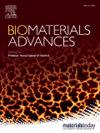Melt electrowriting of hydrophilic/hydrophobic multiblock copolymers for bone tissue regeneration
IF 5.5
2区 医学
Q2 MATERIALS SCIENCE, BIOMATERIALS
Materials Science & Engineering C-Materials for Biological Applications
Pub Date : 2025-01-09
DOI:10.1016/j.bioadv.2024.214167
引用次数: 0
Abstract
Bone-healing complications can occur due to large bone defects or an insufficient bone regeneration capacity. Melt electrowriting (MEW) is a potential candidate for manufacturing synthetic scaffolds that may resolve bone-healing complications. MEW can exploit various biocompatible polymers with a wide range of tissue engineering applications. Poly (ethylene oxide terephthalate)-poly(butylene terephthalate) (PEOT/PBT), a multiblock copolymer family, has emerged as a promising biomaterial to guide cell behavior, particularly in promoting bone differentiation. The polymer is known for its tunability by varying the PEOT/PBT weight ratios to influence the chemical, physical and mechanical properties. Four carefully selected PEOT/PBT compositions investigated in this study with the poly (ethylene oxide terephthalate) content ranging from 36 and 65 wt%. Detailed rheological characterization was performed to determine the optimum printing temperature, followed by optimizing the MEW parameters to fabricate a well-defined and layer-by-layer scaffold for each copolymer composition. The effect of distinct physicochemical properties on cell behavior was also investigated using MG63 cells on both 2D films and MEW scaffolds. MEW scaffolds made from each polymer compositions show good cell attachment and proliferation along with flattened cell morphology in contrast with highly varied performance on 2D films. In addition, the in vitro bioactivity test using simulation body fluid reveals the formation of bone-like apatite layer formation on the MEW scaffolds made from high molecular weight and poly (ethylene oxide terephthalate) composition.

用于骨组织再生的亲水/疏水多嵌段共聚物的熔体电解。
骨愈合并发症可因骨缺损大或骨再生能力不足而发生。熔体电书写(MEW)是一种潜在的候选材料,可用于制造可解决骨愈合并发症的合成支架。MEW可以开发各种生物相容性聚合物,具有广泛的组织工程应用。聚(环氧对苯二甲酸乙酯)-聚(对苯二甲酸丁二酯)(PEOT/PBT)是一种多嵌段共聚物家族,已成为一种有前途的生物材料,可以指导细胞行为,特别是促进骨分化。该聚合物以其可调性而闻名,通过改变PEOT/PBT的重量比来影响化学、物理和机械性能。四种精心挑选的PEOT/PBT组合物在本研究中进行了研究,聚(环氧对苯二甲酸乙酯)含量从36%到65%不等。通过详细的流变学表征来确定最佳打印温度,然后优化MEW参数,为每种共聚物成分制造出定义良好且逐层的支架。我们还利用MG63细胞在二维薄膜和MEW支架上研究了不同的物理化学性质对细胞行为的影响。由每种聚合物组成的MEW支架具有良好的细胞附着和增殖能力以及扁平的细胞形态,而在2D薄膜上则表现出差异很大的性能。此外,利用模拟体液进行体外生物活性试验,揭示了由高分子量和聚环氧对苯二甲酸乙酯组成的MEW支架上形成骨样磷灰石层的形成。
本文章由计算机程序翻译,如有差异,请以英文原文为准。
求助全文
约1分钟内获得全文
求助全文
来源期刊
CiteScore
17.80
自引率
0.00%
发文量
501
审稿时长
27 days
期刊介绍:
Biomaterials Advances, previously known as Materials Science and Engineering: C-Materials for Biological Applications (P-ISSN: 0928-4931, E-ISSN: 1873-0191). Includes topics at the interface of the biomedical sciences and materials engineering. These topics include:
• Bioinspired and biomimetic materials for medical applications
• Materials of biological origin for medical applications
• Materials for "active" medical applications
• Self-assembling and self-healing materials for medical applications
• "Smart" (i.e., stimulus-response) materials for medical applications
• Ceramic, metallic, polymeric, and composite materials for medical applications
• Materials for in vivo sensing
• Materials for in vivo imaging
• Materials for delivery of pharmacologic agents and vaccines
• Novel approaches for characterizing and modeling materials for medical applications
Manuscripts on biological topics without a materials science component, or manuscripts on materials science without biological applications, will not be considered for publication in Materials Science and Engineering C. New submissions are first assessed for language, scope and originality (plagiarism check) and can be desk rejected before review if they need English language improvements, are out of scope or present excessive duplication with published sources.
Biomaterials Advances sits within Elsevier''s biomaterials science portfolio alongside Biomaterials, Materials Today Bio and Biomaterials and Biosystems. As part of the broader Materials Today family, Biomaterials Advances offers authors rigorous peer review, rapid decisions, and high visibility. We look forward to receiving your submissions!

 求助内容:
求助内容: 应助结果提醒方式:
应助结果提醒方式:


